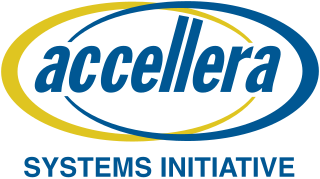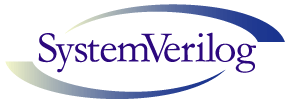Related Research Articles
In computer engineering, a hardware description language (HDL) is a specialized computer language used to describe the structure and behavior of electronic circuits, and most commonly, digital logic circuits.
Electronic design automation (EDA), also referred to as electronic computer-aided design (ECAD), is a category of software tools for designing electronic systems such as integrated circuits and printed circuit boards. The tools work together in a design flow that chip designers use to design and analyze entire semiconductor chips. Since a modern semiconductor chip can have billions of components, EDA tools are essential for their design; this article in particular describes EDA specifically with respect to integrated circuits (ICs).

Synopsys, Inc. is an American electronic design automation (EDA) company headquartered in Sunnyvale, California, that focuses on silicon design and verification, silicon intellectual property and software security and quality. Synopsys supplies tools and services to the semiconductor design and manufacturing industry. Products include tools for logic synthesis and physical design of integrated circuits, simulators for development, and debugging environments that assist in the design of the logic for chips and computer systems. As of 2023, the company is a component of both the Nasdaq-100 and S&P 500 indices.

Magma Design Automation was a software company in the electronic design automation (EDA) industry. The company was founded in 1997 and maintained headquarters in San Jose, California, with facilities throughout North America, Europe and Asia. Magma software products were used in major elements of integrated circuit design, including: synthesis, placement, routing, power management, circuit simulation, verification and analog/mixed-signal design.

Accellera Systems Initiative (Accellera) is a standards organization that supports a mix of user and vendor standards and open interfaces development in the area of electronic design automation (EDA) and integrated circuit (IC) design and manufacturing. It is less constrained than the Institute of Electrical and Electronics Engineers (IEEE) and is therefore the starting place for many standards. Once mature and adopted by the broader community, the standards are usually transferred to the IEEE.
OpenAccess is a proprietary API controlled by the OpenAccess Coalition that aims to facilitate Interoperability of electronic design automation software among the members of that coalition.
SystemC is a set of C++ classes and macros which provide an event-driven simulation interface. These facilities enable a designer to simulate concurrent processes, each described using plain C++ syntax. SystemC processes can communicate in a simulated real-time environment, using signals of all the datatypes offered by C++, some additional ones offered by the SystemC library, as well as user defined. In certain respects, SystemC deliberately mimics the hardware description languages VHDL and Verilog, but is more aptly described as a system-level modeling language.
Formal equivalence checking process is a part of electronic design automation (EDA), commonly used during the development of digital integrated circuits, to formally prove that two representations of a circuit design exhibit exactly the same behavior.
In computer engineering, logic synthesis is a process by which an abstract specification of desired circuit behavior, typically at register transfer level (RTL), is turned into a design implementation in terms of logic gates, typically by a computer program called a synthesis tool. Common examples of this process include synthesis of designs specified in hardware description languages, including VHDL and Verilog. Some synthesis tools generate bitstreams for programmable logic devices such as PALs or FPGAs, while others target the creation of ASICs. Logic synthesis is one step in circuit design in the electronic design automation, the others are place and route and verification and validation.
In semiconductor design, standard-cell methodology is a method of designing application-specific integrated circuits (ASICs) with mostly digital-logic features. Standard-cell methodology is an example of design abstraction, whereby a low-level very-large-scale integration (VLSI) layout is encapsulated into an abstract logic representation.

SystemVerilog, standardized as IEEE 1800, is a hardware description and hardware verification language used to model, design, simulate, test and implement electronic systems. SystemVerilog is based on Verilog and some extensions, and since 2008, Verilog is now part of the same IEEE standard. It is commonly used in the semiconductor and electronic design industry as an evolution of Verilog.
An EDA database is a database specialized for the purpose of electronic design automation. These application specific databases are required because general purpose databases have historically not provided enough performance for EDA applications.
Functional verification is the task of verifying that the logic design conforms to specification. Functional verification attempts to answer the question "Does this proposed design do what is intended?" This is complex and takes the majority of time and effort in most large electronic system design projects. Functional verification is a part of more encompassing design verification, which, besides functional verification, considers non-functional aspects like timing, layout and power.
The Timing closure in VLSI design and electronics engineering is the process by which a logic design of a clocked synchronous circuit consisting of primitive elements such as combinatorial logic gates and sequential logic gates is modified to meet its timing requirements. Unlike in a computer program where there is no explicit delay to perform a calculation, logic circuits have intrinsic and well defined delays to propagate inputs to outputs.

Cadence Design Systems, Inc., headquartered in San Jose, California, is an American multinational computational software company, founded in 1988 by the merger of SDA Systems and ECAD, Inc. The company produces software, hardware, and silicon structures for designing integrated circuits, systems on chips (SoCs), and printed circuit boards.
Unified Power Format (UPF) is the popular name of the Institute of Electrical and Electronics Engineers (IEEE) standard for specifying power intent in power optimization of electronic design automation. The IEEE 1801-2009 release of the standard was based on a donation from the Accellera organization. The current release is IEEE 1801-2018.
IP-XACT, also known as IEEE 1685, is an XML format that defines and describes individual, re-usable electronic circuit designs to facilitate their use in creating integrated circuits. IP-XACT was created by the SPIRIT Consortium as a standard to enable automated configuration and integration through tools and evolving into an IEEE standard.
High-level synthesis (HLS), sometimes referred to as C synthesis, electronic system-level (ESL) synthesis, algorithmic synthesis, or behavioral synthesis, is an automated design process that takes an abstract behavioral specification of a digital system and finds a register-transfer level structure that realizes the given behavior.
In the automated design of integrated circuits, signoff checks is the collective name given to a series of verification steps that the design must pass before it can be taped out. This implies an iterative process involving incremental fixes across the board using one or more check types, and then retesting the design. There are two types of sign-off's: front-end sign-off and back-end sign-off. After back-end sign-off, the chip goes to fabrication. After listing out all the features in the specification, the verification engineer will write coverage for those features to identify bugs, and send back the RTL design to the designer. Bugs, or defects, can include issues like missing features, errors in design, etc. When the coverage reaches a maximum percentage then the verification team will sign it off. By using a methodology like UVM, OVM, or VMM, the verification team develops a reusable environment. Nowadays, UVM is more popular than others.

EVE/ZeBu is a provider of hardware-assisted verification tools for functional verification of Application-specific integrated circuits (ASICs) and system on chip (SOC) designs and for validation of embedded software ahead of implementation in silicon. EVE's hardware acceleration and hardware emulation products work in conjunction with Verilog, SystemVerilog, and VHDL-based simulators from Synopsys, Cadence Design Systems and Mentor Graphics. EVE's flagship product is ZeBu.
References
- ↑ Chi-Ping Hsu, Pushing Power Forward with a Common Power Format - The Process of Getting it Right Archived 2007-09-26 at the Wayback Machine , EETimes, 5 Nov 2006
- ↑ Goering, Richard, IC power standards convergence falters, EETimes, 21 March 2007
- ↑ Goering, Richard, IEEE's patent policy fails to quell EDA standards row Archived 2008-02-19 at the Wayback Machine , EEtimes, 30 April 2007.
- ↑ Silicon Integration Initiative, CPF 1.2 Roadmap, 17 September 2008.